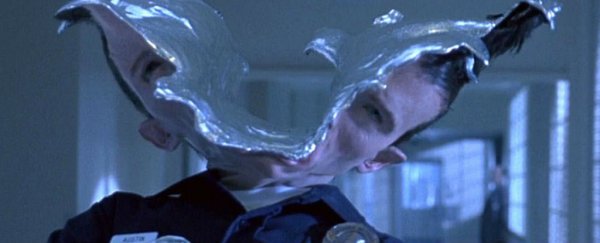Despite the NSA confirming the existence of Skynet, we all should be grateful that technology has not yet advanced to the stage where a liquid metal T-1000 terminator can shape-shift its way into your home and demand to see John Connor.
But scientists in China are making a solid effort make a less sinister version of this scenario at reality, by creating liquid metal droplets that could one day make "self-powered liquid metal machines" a real possibility.
Because of their excellent conductivity, low toxicity, and shape-shifting abilities, liquid metal alloys have been put to good use in targeting cancer cells, creating nature-inspired self-fuelled motors for robots, and many other liquid metal biomaterials.
These applications involve aggressively stretching, compressing, pushing, and transporting the liquid metal droplets, which means making sure they don't get damaged in the process is still the biggest sticking point for scientists.
"Liquid metal droplets have shown outstanding potential to fulfil various emerging needs … such as flexible or even all soft electronics, soft robotics," lead researcher Xuechang Zhou from Shenzhen University told ScienceAlert.
"However, many challenges remain to prepare and make high-performance droplets."
A commonly researched liquid metal droplet is made of gallium, tin, and indium alloy, and despite having many applications, is typically limited by the formation of a thin oxidation layer on the surface of the droplet.
This thin oxidation layer causes the metal droplet to become sticky, and quickly puts an end to any function the liquid metal droplet was supposed to serve.
"To address this issue, we developed a method to vary the chemical properties of the surface to achieve liquid metal droplets with non-stick, high elasticity, mobility and mechanical robustness," says Zhou.
To ensure that the surface wasn't oxidised and the droplet remained non-stick, the scientists used a material that is as at home in the kitchen as it is in the laboratory - Teflon, or PTFE.
They then created liquid metal droplets by using a simple three-step process:
- First, a metal droplet was created by pushing 8 microlitres of metal alloy out of a syringe, and then dunking it in sodium hydroxide for 3 seconds. The sodium hydroxide treatment made sure that the droplets retained their spherical shape.
- The droplets were then rolled in with tiny particles of polytetrafluoroethylene (PTFE or Teflon), which stuck to the surface. The result is the first non-stick, ultra-elastic liquid metal droplets ever produced.
- Finally, to test the robustness of their new creation, the scientists dropped the Teflon coated droplets onto a surface and watched to see what happened. The droplets bounced up and down up nine times ,whereas the non-coated metal droplets stuck to the surface immediately on contact.
"Its elasticity goes beyond tennis and steel balls," says Zhou.
Arguably, the most memorable scene in Terminator 2 is when the T-1000 recombines after being frozen and blown to pieces. In reality, any uncoated liquid metal would probably get stuck to the floor.
This new technique solves this problem by retaining a spherical shape, and the droplets can roll on a surface at an angle of 2 degrees without getting stuck.
Although this is only the first stage of making reconfigurable electronics, the researchers tell ScienceAlert they are hopeful that they can make the droplets move to external stimuli.
"Our future work for the liquid metal includes being able to control the morphology of the droplet upon various conditions," says Zhou.
One thing's for certain - should this material end up being used in self-powered, shape-shifting, liquid metal machines, it'll be time to invest in a big vat of molten metal to protect yourself against chisel-jawed robots from the future.
The research is published in Materials Horizons.
